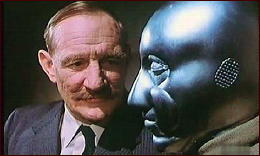Thu 2 Feb 2017
A Movie Review by Jonathan Lewis: WHO? (1975).
Posted by Steve under Reviews , Science Fiction & Fantasy , Suspense & espionage films[7] Comments
WHO? Allied Artists, 1975. Released on video as Roboman. Elliott Gould, Trevor Howard, Joseph Bova, James Noble. Based on the book by Algis Budrys. Director: Jack Gold.
Part cold war thriller, part science fiction, Who? is an enjoyably complex movie that defies conventional expectations and aesthetic norms. Filmed in an almost semi-documentary style, the story not only unfolds in a nonlinear manner, but it also leaves the viewer guessing until the very end as to what the movie’s message or artistic statement, was really all about. Although the movie has its noticeable flaws, it is overall the result of a type of bold experimental film-making that’s sadly all too absent today.

Elliott Gould portrays FBI Agent Sean Rogers. He’s quirky with a hairstyle a little too wild for a counterespionage agent, but an impassioned national servant nonetheless, a true skeptic always doubting and asking questions. He faces what appears to be the challenge of his career in the face of Lucas Martino (Joseph Bova), an American scientist recently released from captivity in East Berlin. The problem facing Rogers is that he’s not sure Martino is who he claims to be. The reason why, as viewers will soon learn, is that Martino has apparently been in a horrific car accident. Eastern bloc scientists reconstructed as a robotic man, one with a silver metal skull and mechanical body parts.
But just who is this robotic man? Is he really Martino or is he a Soviet spy? Rogers simply can’t accept that this silver coated remnant of a man is truly Martino. He’s sure that his Soviet nemesis, Colonel Azarin (Trevor Howard) has somehow managed to either brainwash Martino into being a Soviet agent or that the man under the mask isn’t Martino at all. Complicating matters for Rogers is the fact that Martino seems to be who he says he is. He’s got Martino’s memories and personality traits.
In order to build up to the big reveal as to the actual identity of the man released from Soviet captivity, the story unfolds on two parallel tracks, shifting the viewer’s perspective in terms of both time and space. The present dynamic between Rogers and Martino is contrasted with the past dynamic between Azarin and Martino when the scientist was captive in East Berlin.
As it turns out, there’s not a whole world of difference between Rogers and Azarin. Both are committed patriots who care far more of what Martino could do for them than about Martino himself. Ultimately, however, it is Martino — or whoever it is under the mask — that will decide what his role in this world is going to be. In that sense, the film is very much part of the humanistic science fiction tradition, one that utilizes the tropes of speculative fiction in order to say something about what it means to be an individual.
February 2nd, 2017 at 4:33 pm
Saw it years ago, and I remember it as low-key but interesting. Which is not quite the same thing as entertaining, but I didn’t quit watching it either.
February 2nd, 2017 at 5:51 pm
No, there’s not a lot of action in this one. I saw it long enough ago that I can’t recall if there was even any. But I thought it was entertaining, except when Elliott Gould was on the screen. Not really his kind of part.
February 2nd, 2017 at 7:02 pm
I’ve read the novel but somehow missed the film. I like Trevor Howard a lot and it’s available on dvd. Algis Budrys was one of the better SF writers and this sounds interesting.
February 2nd, 2017 at 8:10 pm
I’ve seen the movie but I’ve never read the book, even though I’ve had a copy for over 40 years. I liked the movie well enough I’m tempted to find where I have the book stored away.
February 2nd, 2017 at 10:08 pm
Great book, only interesting film. Jonathan has pretty much nailed it.
I do agree a bit with Walker Martin, I felt Gould was struggling playing off that expressionless mask.
February 2nd, 2017 at 10:35 pm
David
Perhaps you meant me, not Walker, regarding Elliott Gould?
February 3rd, 2017 at 9:16 pm
Sorry, Steve and Walker. Last time I do this in the phone without my reading glasses. Damn double vision.